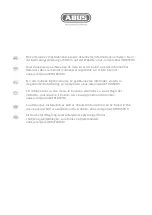
5
To optimise protection, in some instance it may be necessary to use the anchorage sling with suitable boots/gloves/
helmet/ear defenders. In this case, before carrying out the risk-related activity, consult your supplier to ensure that all
your protective products are compatible and suitable for your application.
LIFETIME
The maximum life span of the product is 10 years from the date of manufacture. The life span greatly depends upon the
conditions of usage of the product. Fall arrest equipment / anchorage slings must be inspected once a year by a trained
and competent person. If in any doubts, please contact JSP Safety.
STORAGE AND TRANSPORT
The Personal Protective Equipment must be transported in a package that protects against moisture, mechanical, chemi
-
cal and thermal attack. Store in a cool dry place. Avoid humid & acidic environment for storage.
MAINTENANCE
In case of minor soiling, wipe the anchorage sling with cotton cloth or a soft brush. Do not use any abrasive material. For
intensive cleaning wash the anchorage sling in water at a temperature not more than 40
0
C by using a neutral detergent
(pH7). The washing temperature should not exceed 40
0
C. Do not use acidic or basic detergents.
INSPECTION
PRE-USE CHECK
Users of JSP anchorage slings must carry out a pre-use inspection before each and every use:
•
Checking the webbing and/or rope for: cuts, tears and nicks, abrasion, fraying, thinning, heat damage, mould and
paint, evidence of chemical & U.V light attack, which will be seen as discolouration, softening or hardening of the
webbing and/or rope
•
Checking the stitch patterns for: broken or abraded stitches, loosened stitching, pulled and loops of stitching, long tails
of thread
•
Checking the metal fittings for: rust and pitting, cracks, distortion / deformity, excessive wear
•
Checking the connectors for: rust and pitting, cracks, distortion / deformity, excessive wear, functioning freely and
correctly, correct alignment of the gate,
•
Checking any plastic primary or secondary components for: correct placement, cracks, distortion / deformity, excessive
wear, damage.
If any defect or damage is identified, the connector should not be used. It should be taken to a competent person
responsible for the detailed recorded inspections for a thorough visual and tactile examination.
DETAILED RECORDED INSPECTION
Detailed recorded inspections should:
• Be carried out by a trained competent person to ensure the safety and integrity of the product
• Recorded in the record table contained within these User Instructions
•
Be carried out on a regular basis. The frequency of the detailed recorded inspection should:






































